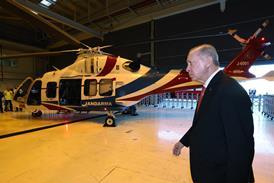Investigators are studying an electrical incident on a BMI Airbus A321 which caused intermittent failure of both pilots' cockpit displays and difficulties with aircraft control.
The UK's Air Accidents Investigation Branch believes an electrical power-generation system fault is behind the incident which, it says, presented "numerous and significant symptoms".
These included an uncommanded rudder trim which caused the A321's left wing to dip by 10° and the jet to deviate to the left of its intended course by some 20nm (37km).
In a bulletin released today the AAIB states that the 24 August event posed a "number of challenges" to the crew and adds that the electronic centralised aircraft monitoring system showed a "large number" of messages but did not clearly indicate the root cause of the malfunction.
"No information or procedures were available to assist the flight crew in effectively diagnosing the problem," the AAIB states. It is recommending that Airbus inform A320-family operators that power-generation faults "may not be clearly annunciated".
BMI's aircraft, G-MEDJ, had been operating at flight level 360 en route between Khartoum and Beirut at night.
While the cockpit-voice and flight-data recorders had been overwritten by the time of notification, the AAIB states that, without warning, the captain's primary flight display, navigation display and other instruments began to flicker, grey out, or go blank.
This situation temporarily appeared to rectify, then recur, and shortly afterwards the same symptoms began affecting the co-pilot's instruments. Standby instruments behaved normally and were used by the co-pilot to fly the jet.
Cockpit lights intermittently went out and the AAIB adds: "The flight crew reported that the aircraft did not seem to respond as expected to their control inputs, and shuddered and jolted repeatedly."
After several minutes the captain read a fault message which required deactivation of a generator and this appeared to resolve the problems associated with the displays, the shaking of the aircraft, and a "chattering" emanating from circuit breakers.
While the generator was supposed to have been reactivated, according to the corresponding checklist, the crew discovered that the symptoms returned and opted to leave it off.
Investigators are trying to ascertain why both pilots' electronic instruments were affected and to determine the source of the failure. The AAIB points out that electrical power interruption can reset the flight augmentation computer, and slightly offset the rudder trim - and a repetitive interruption could result in a "significant" trim input.
Source: Air Transport Intelligence news























